Baker R.C. Flow Measurement Handbook: Industrial Designs, Operating Principles, Performance, and Applications
Подождите немного. Документ загружается.

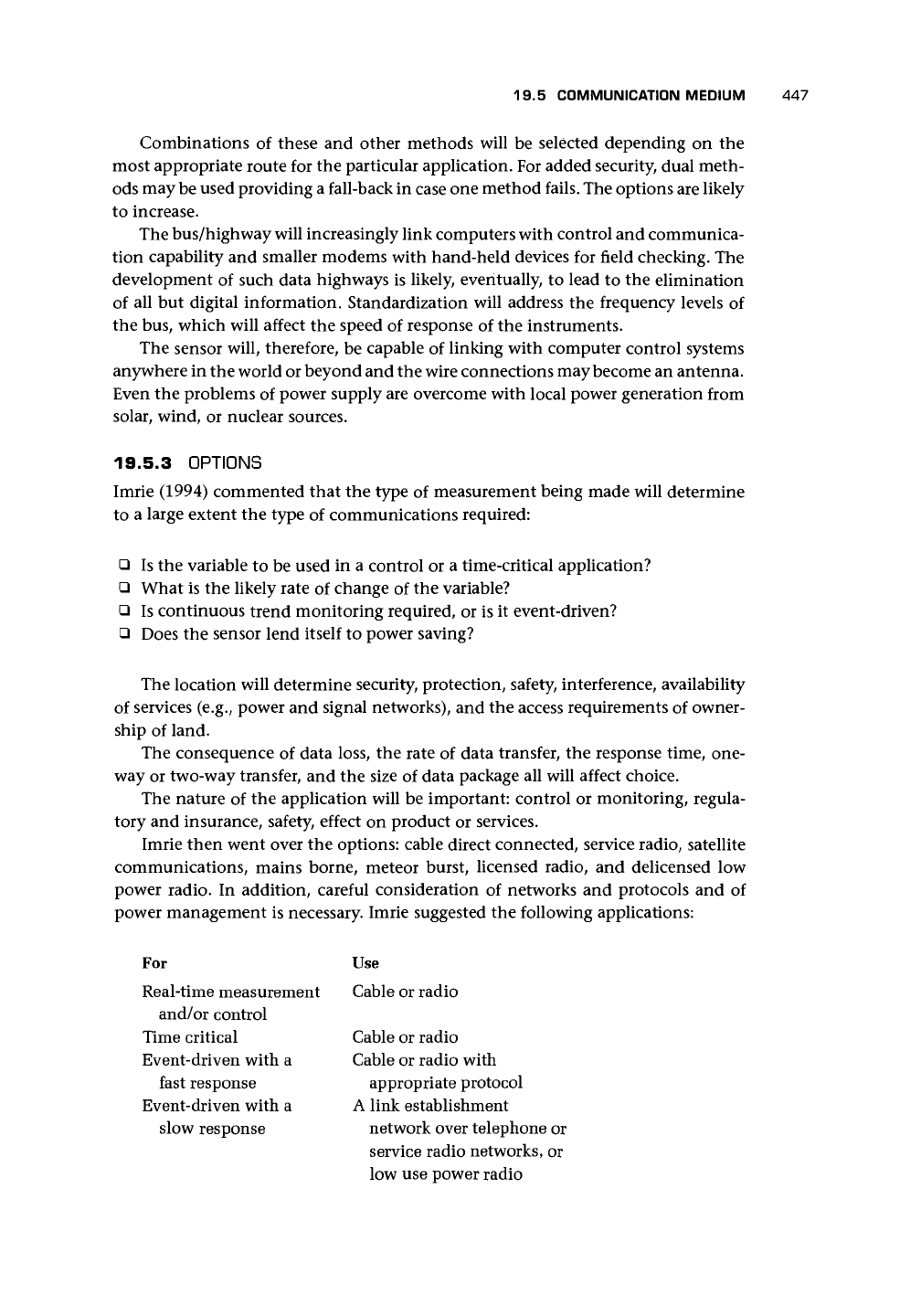
19.5 COMMUNICATION MEDIUM 447
Combinations of these and other methods will be selected depending on the
most appropriate route for the particular application. For added security, dual meth-
ods may be used providing a fall-back in case one method fails. The options are likely
to increase.
The bus/highway will increasingly link computers with control and communica-
tion capability and smaller modems with hand-held devices for field checking. The
development of such data highways is likely, eventually, to lead to the elimination
of all but digital information. Standardization will address the frequency levels of
the bus, which will affect the speed of response of the instruments.
The sensor will, therefore, be capable of linking with computer control systems
anywhere in the world or beyond and the wire connections may become an antenna.
Even the problems of power supply are overcome with local power generation from
solar, wind, or nuclear sources.
19.5.3 OPTIONS
Imrie (1994) commented that the type of measurement being made will determine
to a large extent the type of communications required:
• Is the variable to be used in a control or a time-critical application?
• What is the likely rate of change of the variable?
• Is continuous trend monitoring required, or is it event-driven?
• Does the sensor lend itself to power saving?
The location will determine security, protection, safety, interference, availability
of services (e.g., power and signal networks), and the access requirements of owner-
ship of land.
The consequence of data loss, the rate of data transfer, the response time, one-
way or two-way transfer, and the size of data package all will affect choice.
The nature of the application will be important: control or monitoring, regula-
tory and insurance, safety, effect on product or services.
Imrie then went over the options: cable direct connected, service radio, satellite
communications, mains borne, meteor burst, licensed radio, and delicensed low
power radio. In addition, careful consideration of networks and protocols and of
power management is necessary. Imrie suggested the following applications:
For Use
Real-time measurement Cable or radio
and/or control
Time critical Cable or radio
Event-driven with a Cable or radio with
fast response appropriate protocol
Event-driven with a A link establishment
slow response network over telephone or
service radio networks, or
low use power radio
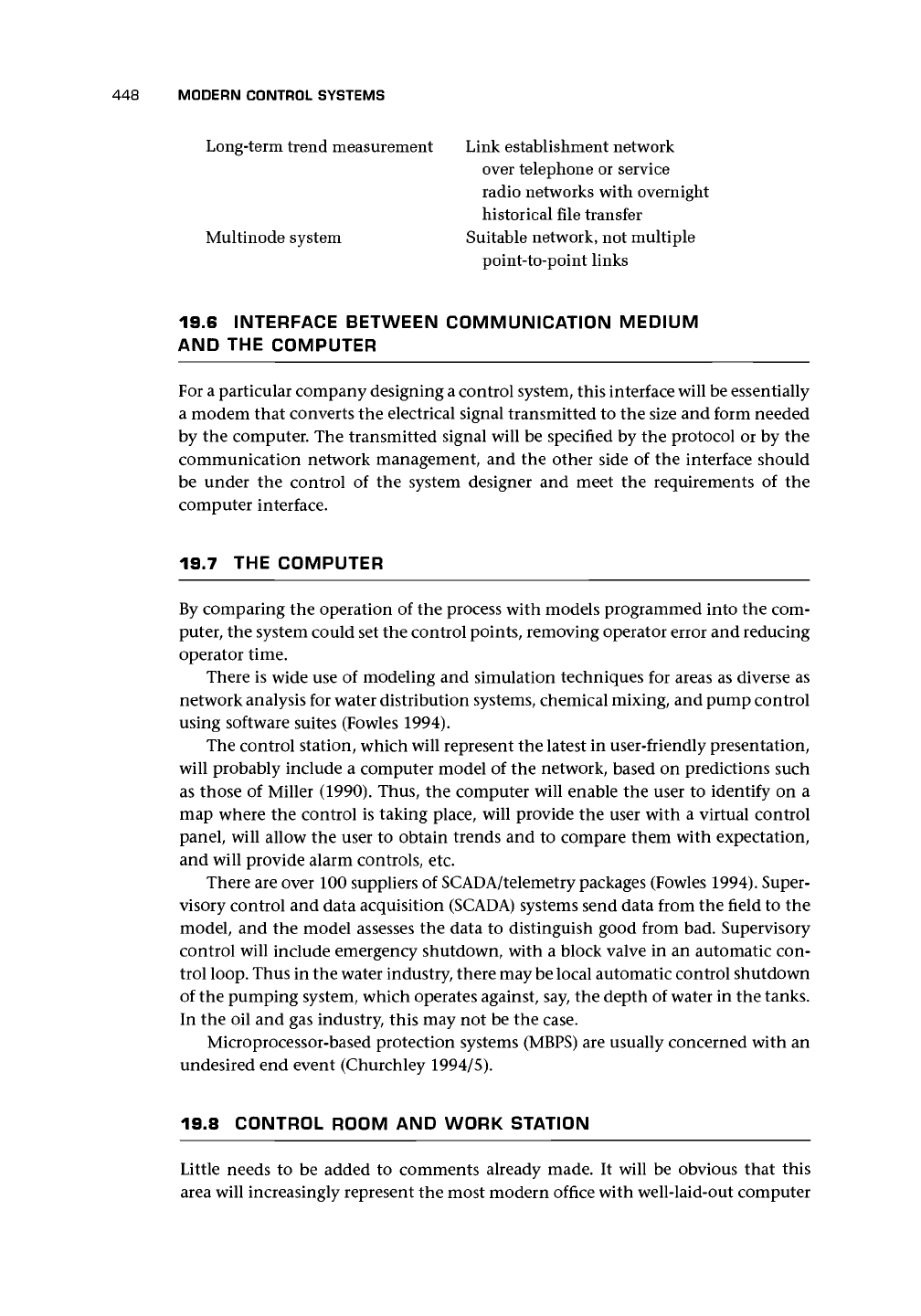
448 MODERN CONTROL SYSTEMS
Long-term trend measurement Link establishment network
over telephone or service
radio networks with overnight
historical file transfer
Multinode system Suitable network, not multiple
point-to-point links
19.6 INTERFACE BETWEEN COMMUNICATION MEDIUM
AND THE COMPUTER
For a particular company designing a control system, this interface will be essentially
a modem that converts the electrical signal transmitted to the size and form needed
by the computer. The transmitted signal will be specified by the protocol or by the
communication network management, and the other side of the interface should
be under the control of the system designer and meet the requirements of the
computer interface.
19.7 THE COMPUTER
By comparing the operation of the process with models programmed into the com-
puter, the system could set the control points, removing operator error and reducing
operator time.
There is wide use of modeling and simulation techniques for areas as diverse as
network analysis for water distribution systems, chemical mixing, and pump control
using software suites (Fowles 1994).
The control station, which will represent the latest in user-friendly presentation,
will probably include a computer model of the network, based on predictions such
as those of Miller (1990). Thus, the computer will enable the user to identify on a
map where the control is taking place, will provide the user with a virtual control
panel, will allow the user to obtain trends and to compare them with expectation,
and will provide alarm controls, etc.
There are over 100 suppliers of SCAD A/telemetry packages (Fowles 1994). Super-
visory control and data acquisition (SCADA) systems send data from the field to the
model, and the model assesses the data to distinguish good from bad. Supervisory
control will include emergency shutdown, with a block valve in an automatic con-
trol loop. Thus in the water industry, there may be local automatic control shutdown
of the pumping system, which operates against, say, the depth of water in the tanks.
In the oil and gas industry, this may not be the case.
Microprocessor-based protection systems (MBPS) are usually concerned with an
undesired end event (Churchley 1994/5).
19.8 CONTROL ROOM AND WORK STATION
Little needs to be added to comments already made. It will be obvious that this
area will increasingly represent the most modern office with well-laid-out computer
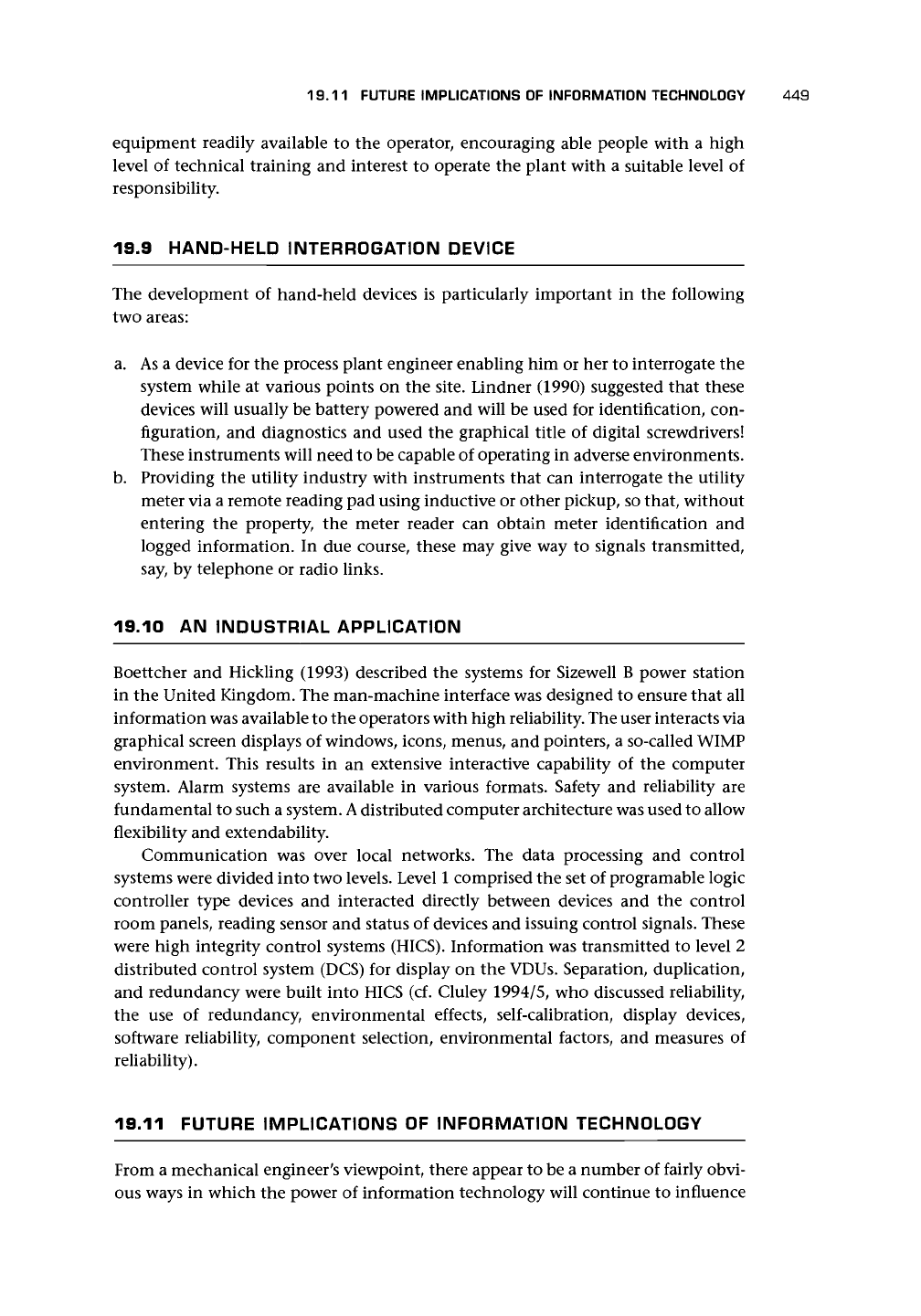
19.11 FUTURE IMPLICATIONS OF INFORMATION TECHNOLOGY 449
equipment readily available to the operator, encouraging able people with a high
level of technical training and interest to operate the plant with a suitable level of
responsibility.
19.9 HAND-HELD INTERROGATION DEVICE
The development of hand-held devices is particularly important in the following
two areas:
a. As a device for the process plant engineer enabling him or her to interrogate the
system while at various points on the site. Lindner (1990) suggested that these
devices will usually be battery powered and will be used for identification, con-
figuration, and diagnostics and used the graphical title of digital screwdrivers!
These instruments will need to be capable of operating in adverse environments.
b.
Providing the utility industry with instruments that can interrogate the utility
meter via a remote reading pad using inductive or other pickup, so that, without
entering the property, the meter reader can obtain meter identification and
logged information. In due course, these may give way to signals transmitted,
say, by telephone or radio links.
19.10 AN INDUSTRIAL APPLICATION
Boettcher and Hickling (1993) described the systems for Sizewell B power station
in the United Kingdom. The man-machine interface was designed to ensure that all
information was available to the operators with high reliability. The user interacts via
graphical screen displays of windows, icons, menus, and pointers, a so-called WIMP
environment. This results in an extensive interactive capability of the computer
system. Alarm systems are available in various formats. Safety and reliability are
fundamental to such a system.
A
distributed computer architecture was used to allow
flexibility and extendability.
Communication was over local networks. The data processing and control
systems were divided into two levels. Level 1 comprised the set of programable logic
controller type devices and interacted directly between devices and the control
room panels, reading sensor and status of devices and issuing control signals. These
were high integrity control systems (HICS). Information was transmitted to level 2
distributed control system (DCS) for display on the VDUs. Separation, duplication,
and redundancy were built into HICS (cf. Cluley 1994/5, who discussed reliability,
the use of redundancy, environmental effects, self-calibration, display devices,
software reliability, component selection, environmental factors, and measures of
reliability).
19.11 FUTURE IMPLICATIONS OF INFORMATION TECHNOLOGY
From a mechanical engineer's viewpoint, there appear to be a number of fairly obvi-
ous ways in which the power of information technology will continue to influence
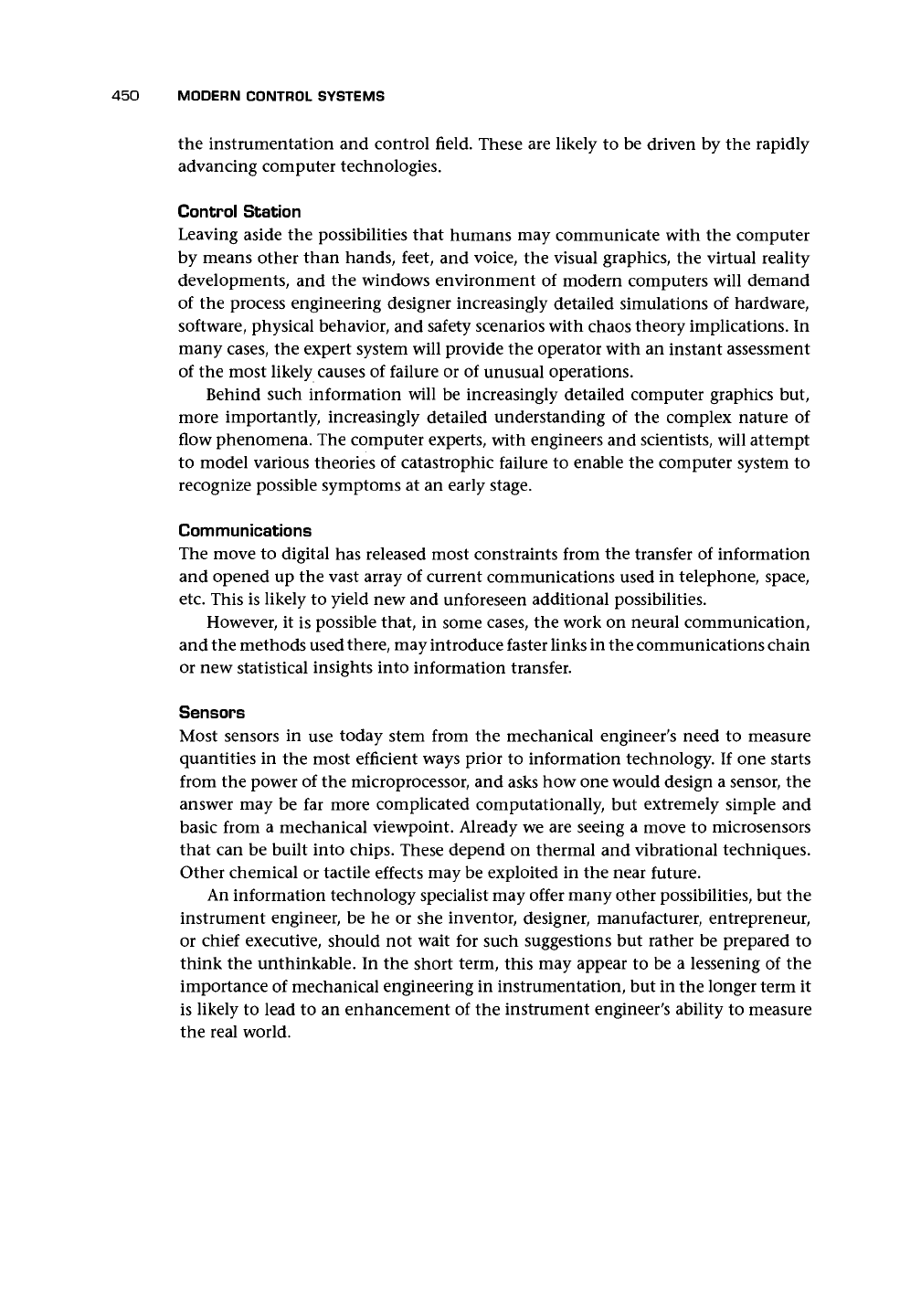
450 MODERN CONTROL SYSTEMS
the instrumentation and control field. These are likely to be driven by the rapidly
advancing computer technologies.
Control Station
Leaving aside the possibilities that humans may communicate with the computer
by means other than hands, feet, and voice, the visual graphics, the virtual reality
developments, and the windows environment of modern computers will demand
of the process engineering designer increasingly detailed simulations of hardware,
software, physical behavior, and safety scenarios with chaos theory implications. In
many cases, the expert system will provide the operator with an instant assessment
of the most likely causes of failure or of unusual operations.
Behind such information will be increasingly detailed computer graphics but,
more importantly, increasingly detailed understanding of the complex nature of
flow phenomena. The computer experts, with engineers and scientists, will attempt
to model various theories of catastrophic failure to enable the computer system to
recognize possible symptoms at an early stage.
Communications
The move to digital has released most constraints from the transfer of information
and opened up the vast array of current communications used in telephone, space,
etc.
This is likely to yield new and unforeseen additional possibilities.
However, it is possible that, in some cases, the work on neural communication,
and the methods used there, may introduce faster links in the communications chain
or new statistical insights into information transfer.
Sensors
Most sensors in use today stem from the mechanical engineer's need to measure
quantities in the most efficient ways prior to information technology. If one starts
from the power of the microprocessor, and asks how one would design a sensor, the
answer may be far more complicated computationally, but extremely simple and
basic from a mechanical viewpoint. Already we are seeing a move to microsensors
that can be built into chips. These depend on thermal and vibrational techniques.
Other chemical or tactile effects may be exploited in the near future.
An information technology specialist may offer many other possibilities, but the
instrument engineer, be he or she inventor, designer, manufacturer, entrepreneur,
or chief executive, should not wait for such suggestions but rather be prepared to
think the unthinkable. In the short term, this may appear to be a lessening of the
importance of mechanical engineering in instrumentation, but in the longer term it
is likely to lead to an enhancement of the instrument engineer's ability to measure
the real world.
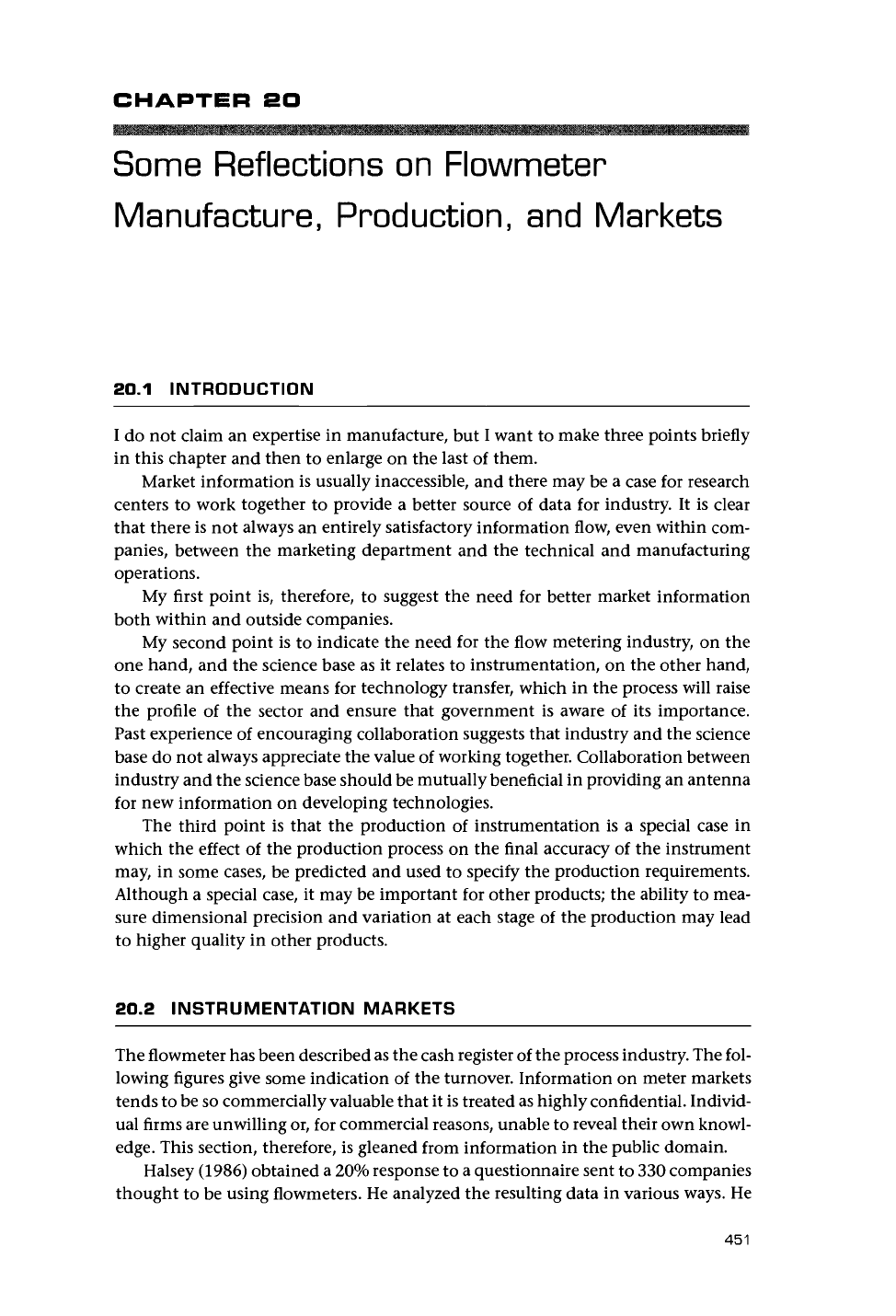
CHAPTER
SO
Some Reflections on Flowmeter
Manufacture, Production, and Markets
20.1 INTRODUCTION
I do not claim an expertise in manufacture, but I want to make three points briefly
in this chapter and then to enlarge on the last of them.
Market information is usually inaccessible, and there may be a case for research
centers to work together to provide a better source of data for industry. It is clear
that there is not always an entirely satisfactory information flow, even within com-
panies, between the marketing department and the technical and manufacturing
operations.
My first point is, therefore, to suggest the need for better market information
both within and outside companies.
My second point is to indicate the need for the flow metering industry, on the
one hand, and the science base as it relates to instrumentation, on the other hand,
to create an effective means for technology transfer, which in the process will raise
the profile of the sector and ensure that government is aware of its importance.
Past experience of encouraging collaboration suggests that industry and the science
base do not always appreciate the value of working together. Collaboration between
industry and the science base should be mutually beneficial in providing an antenna
for new information on developing technologies.
The third point is that the production of instrumentation is a special case in
which the effect of the production process on the final accuracy of the instrument
may, in some cases, be predicted and used to specify the production requirements.
Although a special case, it may be important for other products; the ability to mea-
sure dimensional precision and variation at each stage of the production may lead
to higher quality in other products.
20.2 INSTRUMENTATION MARKETS
The flowmeter has been described as the cash register of the process industry. The fol-
lowing figures give some indication of the turnover. Information on meter markets
tends to be so commercially valuable that it is treated as highly confidential. Individ-
ual firms are unwilling or, for commercial reasons, unable to reveal their own knowl-
edge.
This section, therefore, is gleaned from information in the public domain.
Halsey (1986) obtained a 20% response to a questionnaire sent to 330 companies
thought to be using flowmeters. He analyzed the resulting data in various ways. He
451
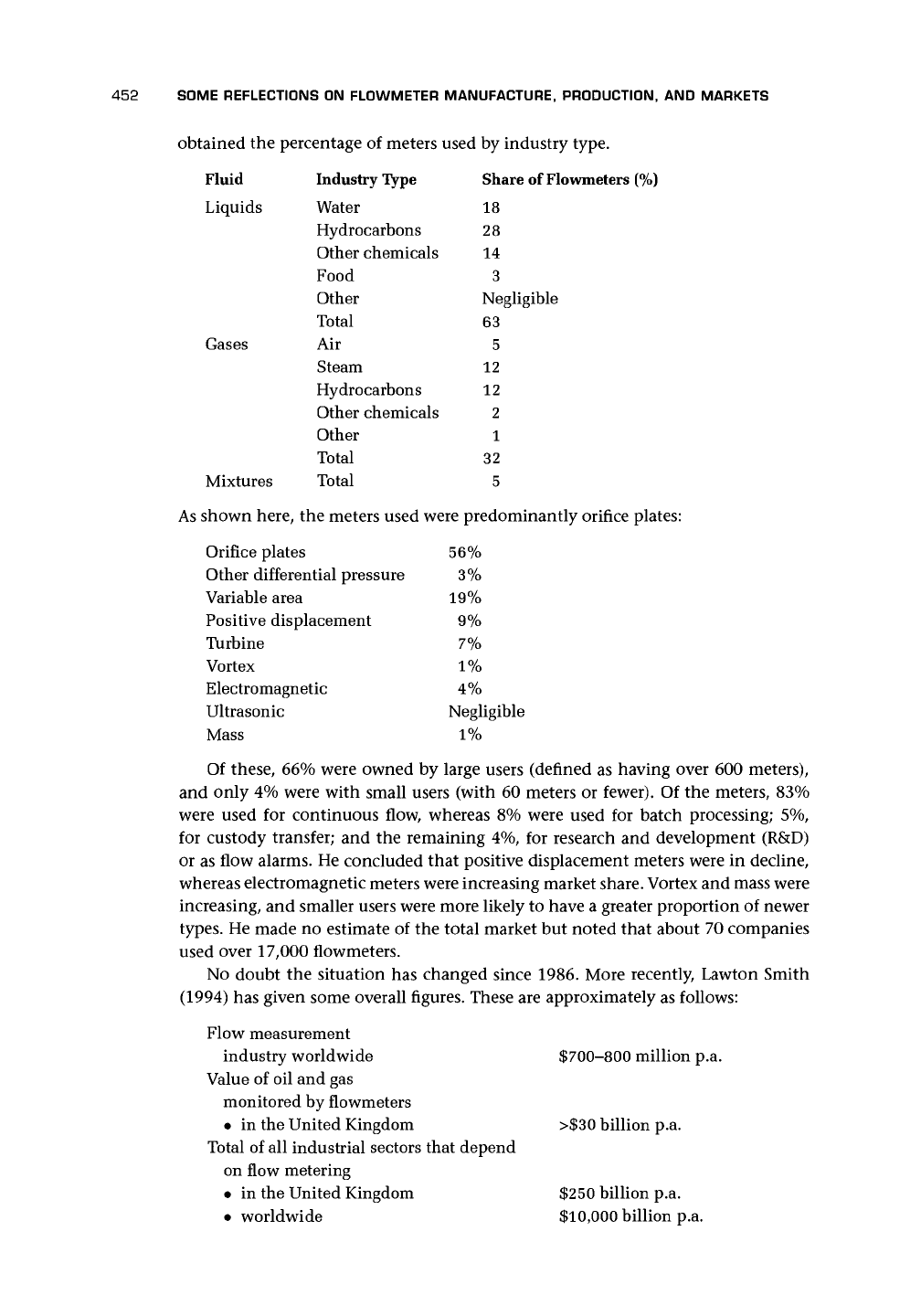
452
SOME REFLECTIONS ON FLOWMETER MANUFACTURE, PRODUCTION, AND MARKETS
obtained the percentage of meters used by industry type.
Fluid Industry Type
Liquids Water
Hydrocarbons
Other chemicals
Food
Other
Total
Gases Air
Steam
Hydrocarbons
Other chemicals
Other
Total
Mixtures Total
Share of Flowmeters (%)
18
28
14
3
Negligible
63
5
12
12
2
1
32
5
ihown here, the meters used were predominantly orifice pla
Orifice plates
Other differential pressure
Variable area
Positive displacement
Turbine
Vortex
Electromagnetic
Ultrasonic
Mass
56%
3%
19%
9%
7%
1%
4%
Negligible
1%
Of these, 66% were owned by large users (defined as having over 600 meters),
and only 4% were with small users (with 60 meters or fewer). Of the meters, 83%
were used for continuous flow, whereas 8% were used for batch processing; 5%,
for custody transfer; and the remaining 4%, for research and development (R&D)
or as flow alarms. He concluded that positive displacement meters were in decline,
whereas electromagnetic meters were increasing market share. Vortex and mass were
increasing, and smaller users were more likely to have a greater proportion of newer
types.
He made no estimate of the total market but noted that about 70 companies
used over 17,000 flowmeters.
No doubt the situation has changed since 1986. More recently, Lawton Smith
(1994) has given some overall figures. These are approximately as follows:
Flow measurement
industry worldwide
Value of oil and gas
monitored by flowmeters
• in the United Kingdom
Total of all industrial sectors that depend
on flow metering
• in the United Kingdom
• worldwide
$700-800 million p.a.
>$30 billion p.a.
$250 billion p.a.
$10,000 billion p.a.
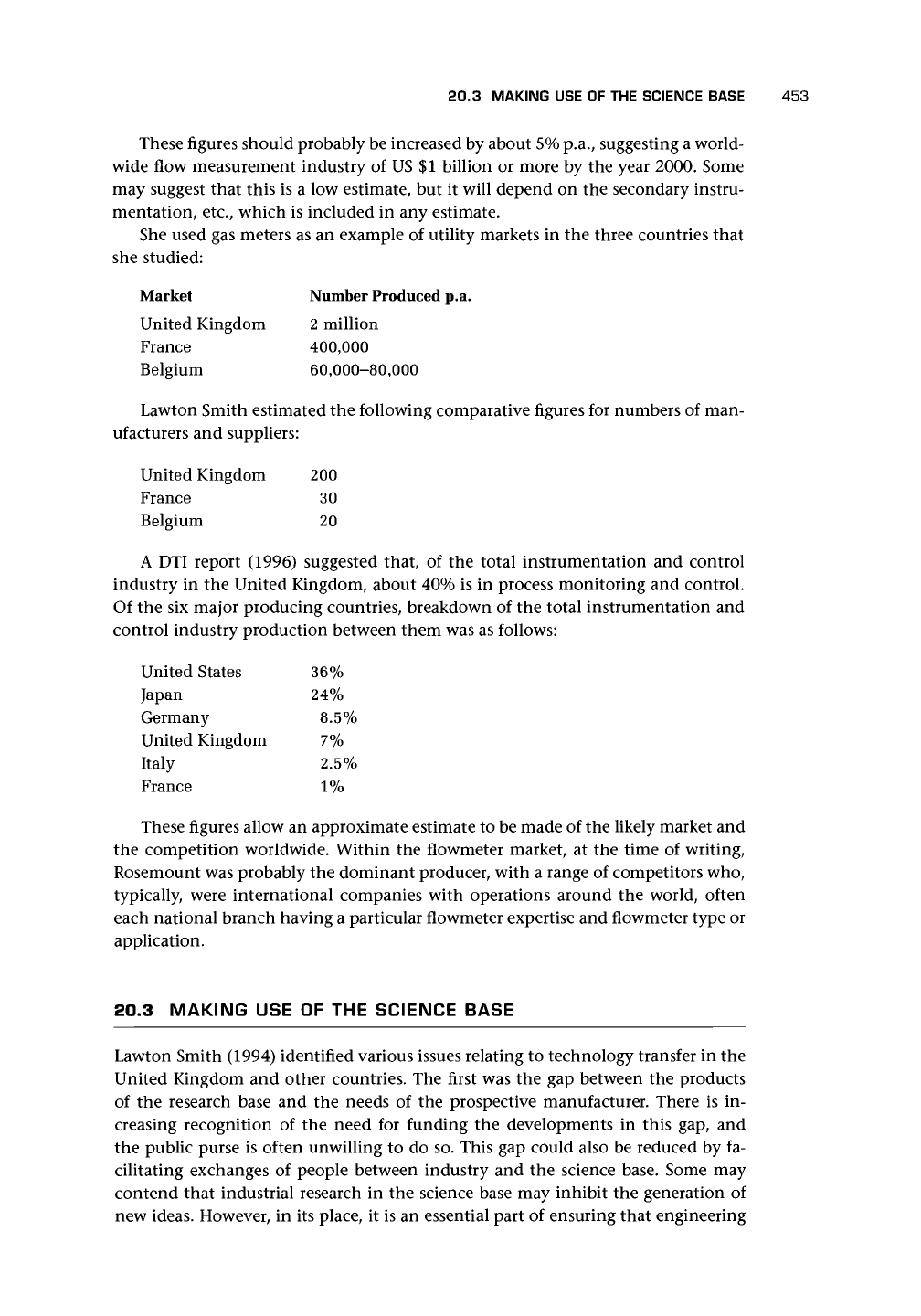
20.3 MAKING USE OF THE SCIENCE BASE 453
These figures should probably be increased by about 5% p.a.
;
suggesting a world-
wide flow measurement industry of US $1 billion or more by the year 2000. Some
may suggest that this is a low estimate, but it will depend on the secondary instru-
mentation, etc., which is included in any estimate.
She used gas meters as an example of utility markets in the three countries that
she studied:
Market Number Produced p.a.
United Kingdom 2 million
France 400,000
Belgium 60,000-80,000
Lawton Smith estimated the following comparative figures for numbers of man-
ufacturers and suppliers:
United Kingdom
France
Belgium
200
30
20
A DTI report (1996) suggested that, of the total instrumentation and control
industry in the United Kingdom, about 40% is in process monitoring and control.
Of the six major producing countries, breakdown of the total instrumentation and
control industry production between them was as follows:
United States
Japan
Germany
United Kingdom
Italy
France
36%
24%
8.5%
7%
2.5%
1%
These figures allow an approximate estimate to be made of the likely market and
the competition worldwide. Within the flowmeter market, at the time of writing,
Rosemount was probably the dominant producer, with a range of competitors who,
typically, were international companies with operations around the world, often
each national branch having a particular flowmeter expertise and flowmeter type or
application.
20.3 MAKING USE OF THE SCIENCE BASE
Lawton Smith (1994) identified various issues relating to technology transfer in the
United Kingdom and other countries. The first was the gap between the products
of the research base and the needs of the prospective manufacturer. There is in-
creasing recognition of the need for funding the developments in this gap, and
the public purse is often unwilling to do so. This gap could also be reduced by fa-
cilitating exchanges of people between industry and the science base. Some may
contend that industrial research in the science base may inhibit the generation of
new ideas. However, in its place, it is an essential part of ensuring that engineering
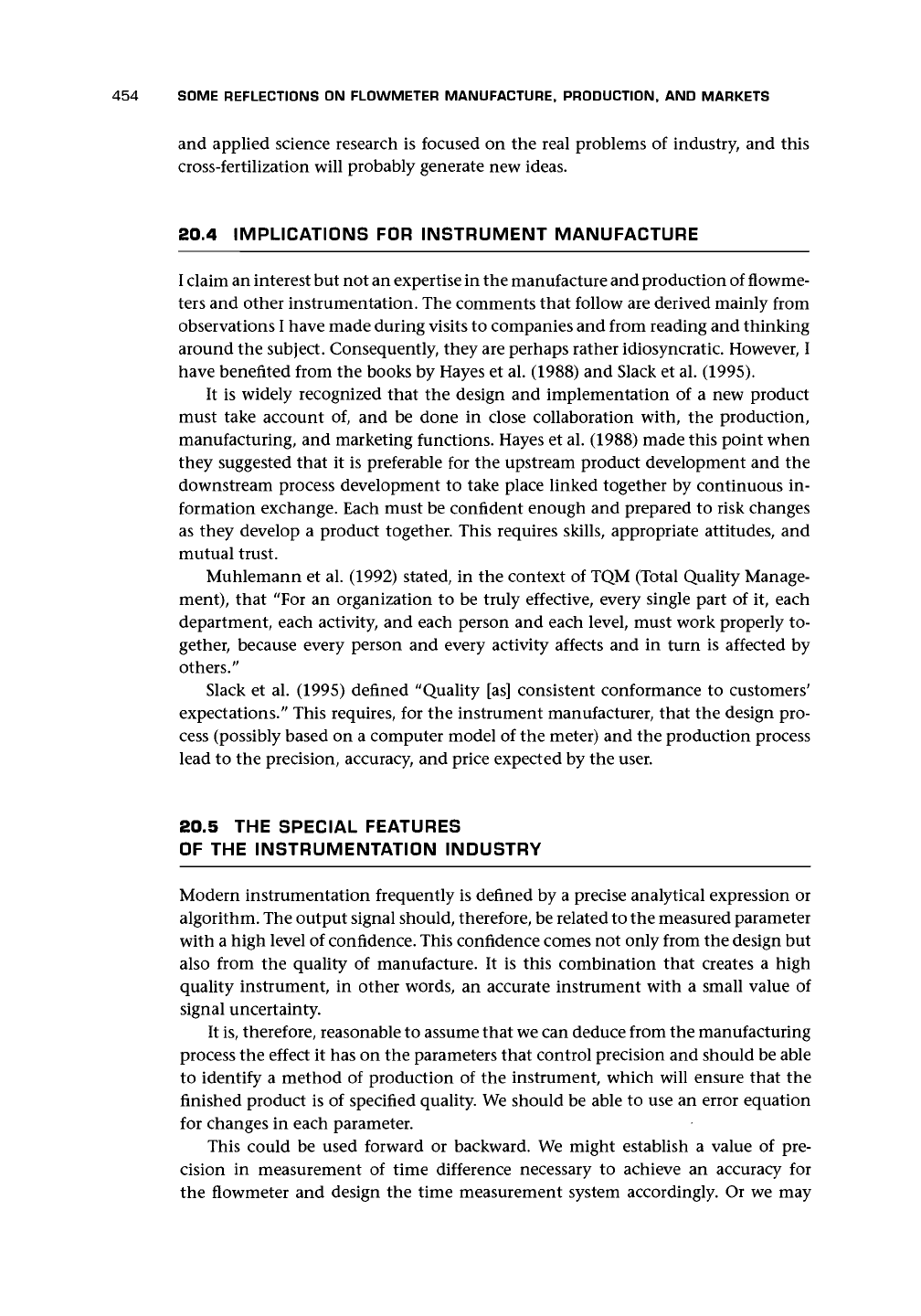
454 SOME REFLECTIONS ON FLOWMETER MANUFACTURE, PRODUCTION, AND MARKETS
and applied science research is focused on the real problems of industry, and this
cross-fertilization will probably generate new ideas.
20.4 IMPLICATIONS FOR INSTRUMENT MANUFACTURE
I
claim an interest but not an expertise in the manufacture and production of flowme-
ters and other instrumentation. The comments that follow are derived mainly from
observations I have made during visits to companies and from reading and thinking
around the subject. Consequently, they are perhaps rather idiosyncratic. However, I
have benefited from the books by Hayes et al. (1988) and Slack et al. (1995).
It is widely recognized that the design and implementation of a new product
must take account of, and be done in close collaboration with, the production,
manufacturing, and marketing functions. Hayes et al. (1988) made this point when
they suggested that it is preferable for the upstream product development and the
downstream process development to take place linked together by continuous in-
formation exchange. Each must be confident enough and prepared to risk changes
as they develop a product together. This requires skills, appropriate attitudes, and
mutual trust.
Muhlemann et al. (1992) stated, in the context of TQM (Total Quality Manage-
ment),
that "For an organization to be truly effective, every single part of it, each
department, each activity, and each person and each level, must work properly to-
gether, because every person and every activity affects and in turn is affected by
others."
Slack et al. (1995) denned "Quality [as] consistent conformance to customers'
expectations." This requires, for the instrument manufacturer, that the design pro-
cess (possibly based on a computer model of the meter) and the production process
lead to the precision, accuracy, and price expected by the user.
20.5 THE SPECIAL FEATURES
OF THE INSTRUMENTATION INDUSTRY
Modern instrumentation frequently is denned by a precise analytical expression or
algorithm. The output signal should, therefore, be related to the measured parameter
with a high level of confidence. This confidence comes not only from the design but
also from the quality of manufacture. It is this combination that creates a high
quality instrument, in other words, an accurate instrument with a small value of
signal uncertainty.
It
is,
therefore, reasonable to assume that we can deduce from the manufacturing
process the effect it has on the parameters that control precision and should be able
to identify a method of production of the instrument, which will ensure that the
finished product is of specified quality. We should be able to use an error equation
for changes in each parameter.
This could be used forward or backward. We might establish a value of pre-
cision in measurement of time difference necessary to achieve an accuracy for
the flowmeter and design the time measurement system accordingly. Or we may
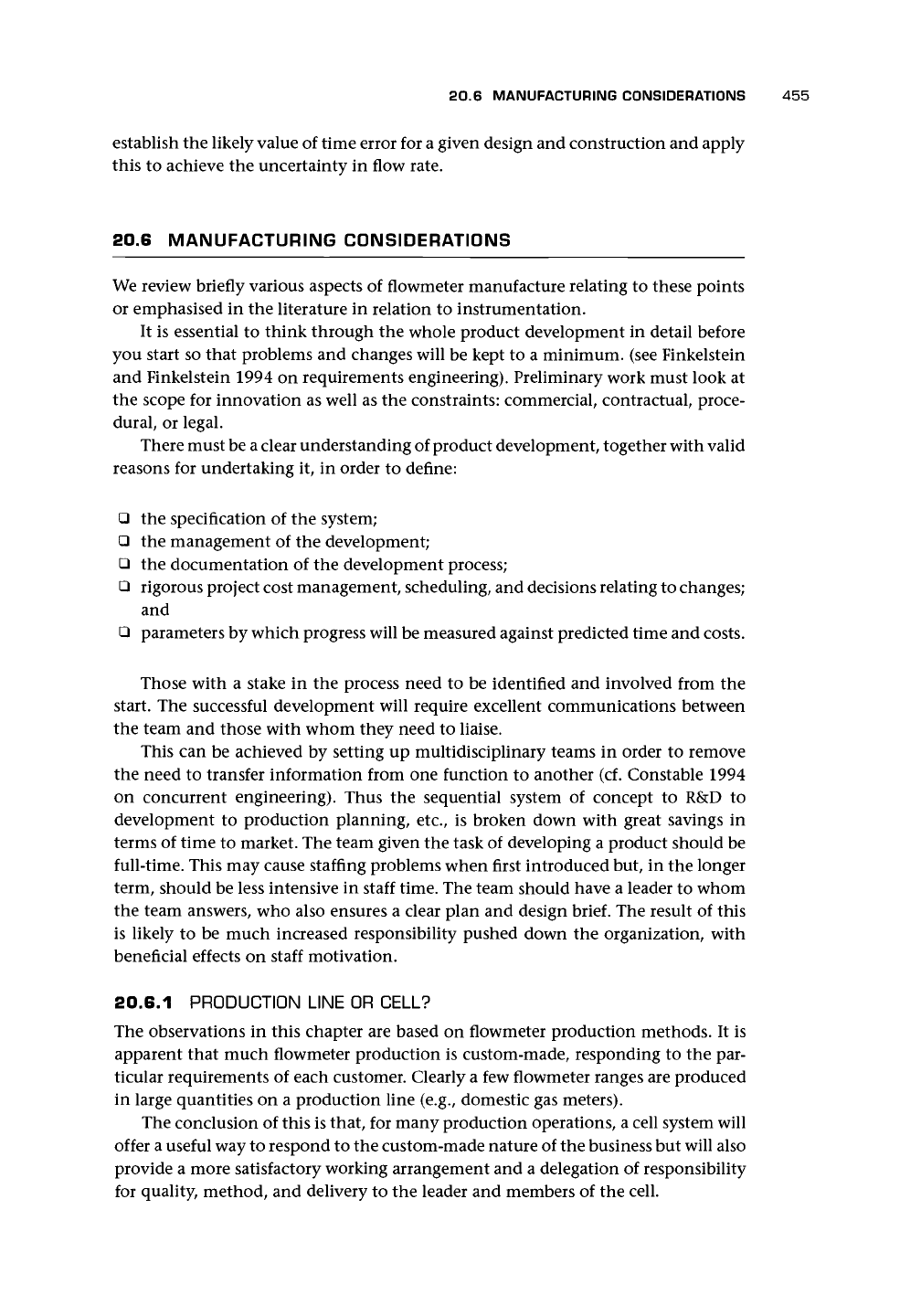
20.6 MANUFACTURING CONSIDERATIONS 455
establish the likely value of time error for a given design and construction and apply
this to achieve the uncertainty in flow rate.
20.6 MANUFACTURING CONSIDERATIONS
We review briefly various aspects of flowmeter manufacture relating to these points
or emphasised in the literature in relation to instrumentation.
It is essential to think through the whole product development in detail before
you start so that problems and changes will be kept to a minimum, (see Finkelstein
and Finkelstein 1994 on requirements engineering). Preliminary work must look at
the scope for innovation as well as the constraints: commercial, contractual, proce-
dural, or legal.
There must be a clear understanding of product development, together with valid
reasons for undertaking it, in order to define:
• the specification of the system;
• the management of the development;
• the documentation of the development process;
• rigorous project cost management, scheduling, and decisions relating to changes;
and
• parameters by which progress will be measured against predicted time and costs.
Those with a stake in the process need to be identified and involved from the
start. The successful development will require excellent communications between
the team and those with whom they need to liaise.
This can be achieved by setting up multidisciplinary teams in order to remove
the need to transfer information from one function to another (cf. Constable 1994
on concurrent engineering). Thus the sequential system of concept to R&D to
development to production planning, etc., is broken down with great savings in
terms of time to market. The team given the task of developing a product should be
full-time. This may cause staffing problems when first introduced but, in the longer
term, should be less intensive in staff time. The team should have a leader to whom
the team answers, who also ensures a clear plan and design
brief.
The result of this
is likely to be much increased responsibility pushed down the organization, with
beneficial effects on staff motivation.
20.6.1 PRODUCTION LINE OR CELL?
The observations in this chapter are based on flowmeter production methods. It is
apparent that much flowmeter production is custom-made, responding to the par-
ticular requirements of each customer. Clearly a few flowmeter ranges are produced
in large quantities on a production line (e.g., domestic gas meters).
The conclusion of this is that, for many production operations, a cell system will
offer a useful way to respond to the custom-made nature of the business but will also
provide a more satisfactory working arrangement and a delegation of responsibility
for quality, method, and delivery to the leader and members of the cell.
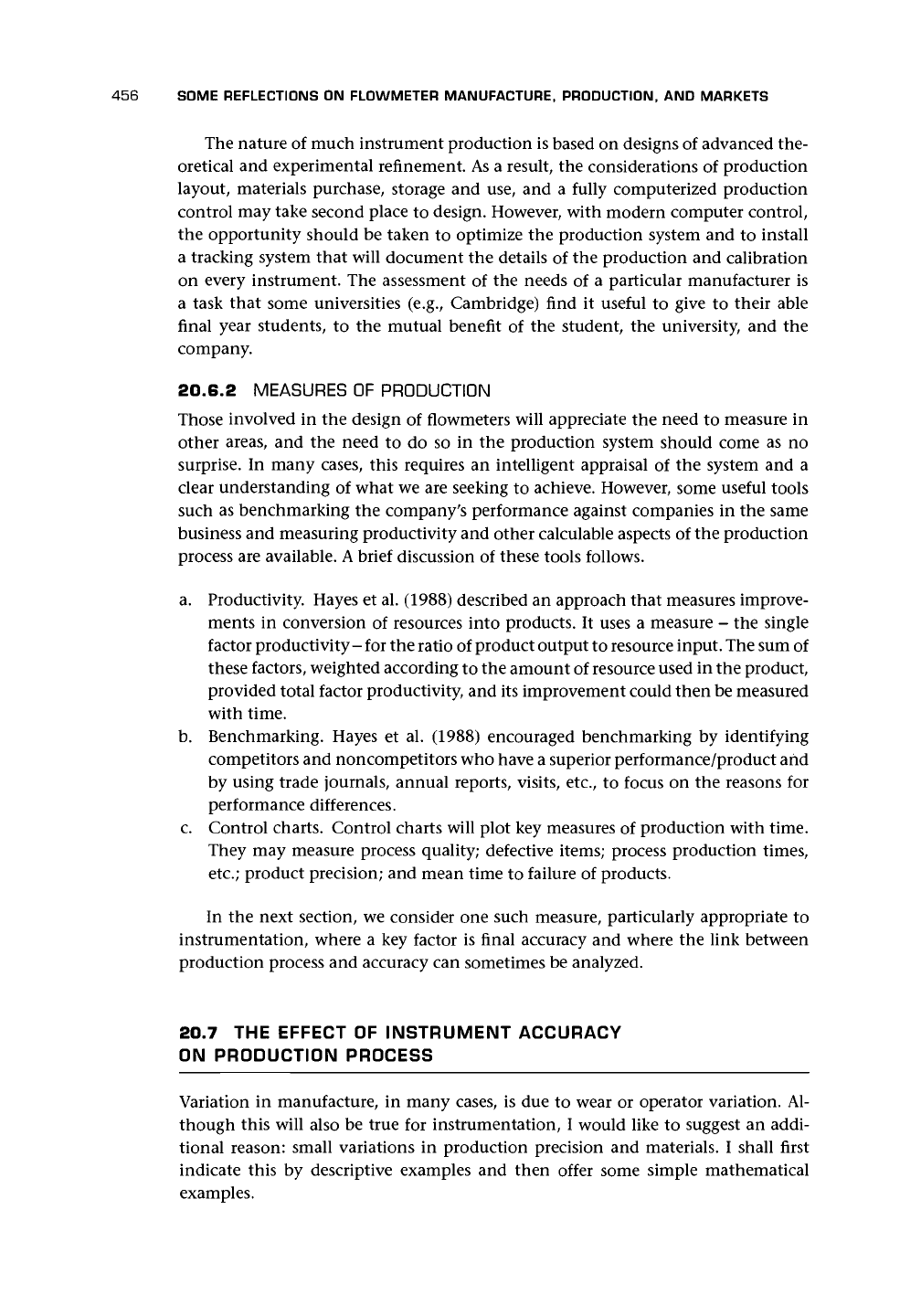
456 SOME REFLECTIONS ON FLOWMETER MANUFACTURE, PRODUCTION, AND MARKETS
The nature of much instrument production is based on designs of advanced the-
oretical and experimental refinement. As a result, the considerations of production
layout, materials purchase, storage and use, and a fully computerized production
control may take second place to design. However, with modern computer control,
the opportunity should be taken to optimize the production system and to install
a tracking system that will document the details of the production and calibration
on every instrument. The assessment of the needs of a particular manufacturer is
a task that some universities (e.g., Cambridge) find it useful to give to their able
final year students, to the mutual benefit of the student, the university, and the
company.
20.6.2 MEASURES OF PRODUCTION
Those involved in the design of flowmeters will appreciate the need to measure in
other areas, and the need to do so in the production system should come as no
surprise. In many cases, this requires an intelligent appraisal of the system and a
clear understanding of what we are seeking to achieve. However, some useful tools
such as benchmarking the company's performance against companies in the same
business and measuring productivity and other calculable aspects of the production
process are available.
A
brief discussion of these tools follows.
a. Productivity. Hayes et al. (1988) described an approach that measures improve-
ments in conversion of resources into products. It uses a measure - the single
factor productivity - for the ratio of product output to resource input. The sum of
these factors, weighted according to the amount of resource used in the product,
provided total factor productivity, and its improvement could then be measured
with time.
b.
Benchmarking. Hayes et al. (1988) encouraged benchmarking by identifying
competitors and noncompetitors who have a superior performance/product and
by using trade journals, annual reports, visits, etc., to focus on the reasons for
performance differences.
c. Control charts. Control charts will plot key measures of production with time.
They may measure process quality; defective items; process production times,
etc.;
product precision; and mean time to failure of products.
In the next section, we consider one such measure, particularly appropriate to
instrumentation, where a key factor is final accuracy and where the link between
production process and accuracy can sometimes be analyzed.
20.7 THE EFFECT OF INSTRUMENT ACCURACY
ON PRODUCTION PROCESS
Variation in manufacture, in many cases, is due to wear or operator variation. Al-
though this will also be true for instrumentation, I would like to suggest an addi-
tional reason: small variations in production precision and materials. I shall first
indicate this by descriptive examples and then offer some simple mathematical
examples.
